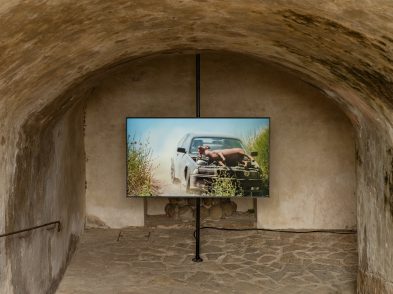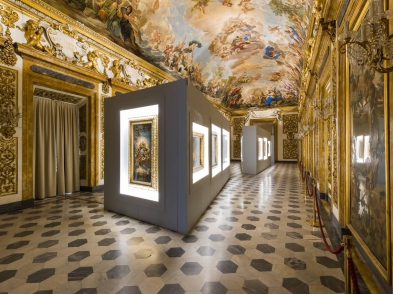‘Isn’t life a
series of images that change as they repeat themselves?’ asked Andy Warhol. The
story of how Warhol repeated the paintings of Giorgio de Chirico, the Italian
modern master who influenced surrealism, unfolds in the paintings, drawings,
prints and sculpture currently featured in the exhibition, La Neometafisica: De
Chirico & Warhol, at the Frediano Farsetti Gallery in Florence. Indeed,
late in his life, de Chirico recreated the same enigmatic and unsettling
paintings that had delivered critical attention in his youthful
prime-repetition that no other than Warhol brought to the mainstream and made
famous.
When de
Chirico’s metaphysical paintings were first seen in public in Paris around the
time of World War I, they caused deep surprise. ‘Metaphysical’ specifically
describes, in art history’s terminology, his work in that crucial period.
Crisply painted, predominantly in yellow and green, his canvases depicted city
squares, sharply receding arcades, passing trains and distant brick walls.
These
piazzas, however, were eerily uninhabited, except for a few isolated figures
and statues casting long shadows. Classical sculptures and featureless
dressmakers’ dummies joined other troubling symbols to occupy limited spaces
and claustrophobic interiors with steeply rising floors.
Although
defying straightforward explanation, these expressive substitutes for absent
humanity reappeared unforgettably in different combinations, often with other
symbols-compasses, trains, easels and set squares-in painting after painting.
Surprise is
the hallmark of de Chirico and the successive generations of western artists
that he has inspired. His cryptic compositions shuttle between past and
present, as if time was on a loop, and human fate with it, awaiting discovery
by a sympathetic mind. At the same moment, they sum up a particular view of the
modern age, its banalities, absurdities and novelty.
René
Magritte, Salvador Dalí and Edward Hopper admired him; the surrealists hailed
him (prior to rejecting him); and poets from Apollinaire to Sylvia Plath have
cited him in their writing. Unsurprisingly, Andy Warhol was drawn to the
paintings’ puzzling atmosphere. Since the early 1960s, the American’s fortunes
had ascended with work whose first effect was also surprise.
When pop art
was receiving attention on several levels for borrowing imagery from everyday
culture, Warhol began showing the paintings and prints he made in which soup
cans and Brillo packaging were repeated over and over.
For Warhol,
with his background in advertising, was among the first to recognize that new
urban, consumer societies were influenced by symbols, images and the mass
media. Like de Chirico, he was making art for a culture in which distinctions
between reality and the unreal were becoming confused, even interchangeable.
An Italian
collector of both artists’ work, businessman Carlo Bilotti had the idea in 1982
of asking Warhol to interpret de Chirico’s vision in his own individual style.
The two artists had once met at a diplomatic function in New York City in 1974,
although what passed between them on that occasion is unrecorded. But they had
much in common, not least a tendency to repeat their work.
For Warhol,
repetition was a cornerstone of his practice. With de Chirico, the cause was
partly financial. In the last 20 years of his life (he died in 1978) he made
again paintings first created before 1925 and even went as far as to sign fakes
made by other artists-another surprise, it seems, although de Chirico may have
been asserting that the idea was mightier than the actual, physical artwork. By
devaluing his own production, he was pulling the rug from under the art market.
So one
iconoclast appealed to another. Warhol told Bilotti that de Chirico was among
his favourite artists ‘because he repeats himself. He does the same painting
over and over again. De Chirico was the father of Pop, repeating images so that
people would retain them, understand them.’
By setting
numerous important paintings by de Chirico alongside Warhol drawings and a
print that repeats the same de Chirico image four times, this exhibition
rekindles a surprisingly subversive artistic conversation.






